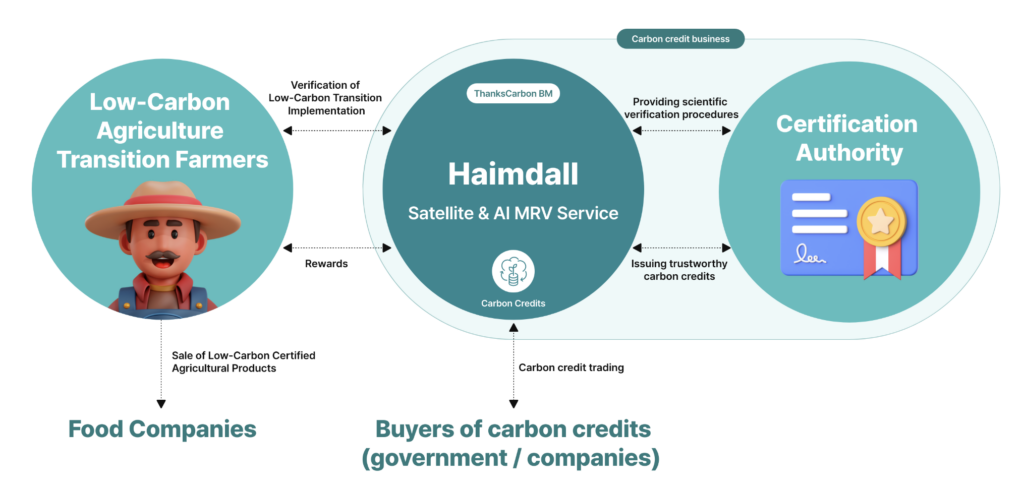‘Thanks Carbon’ helps ESG implementation and measures nature with AI [Climate is an opportunity].
“ESG, which has been focused on assessment and planning, needs to move toward 'implementation,'” says who provides ESG implementation projects for companies and monitors carbon emissions to achieve carbon neutrality. Thanks Carbon is a climate tech startup founded in 2021.
2024-08-23Mandatory ESG disclosure has become a hot topic. The Korea Accounting Standards Board’s Sustainability Standards Board (KSSB), which establishes ESG disclosure standards in Korea, released the Draft Korea ESG Disclosure Standards in late April and is collecting comments until the end of August.
But disclosure alone won’t solve the climate problem. “ESG, which has been focused on assessment and planning, needs to move toward ‘implementation,’” says who provides ESG implementation projects for companies and monitors carbon emissions to achieve carbon neutrality. Thanks Carbon is a climate tech startup founded in 2021.
“I think we need to make big changes to keep the global average temperature rise within 1.5℃, and we need to create a ‘carbon economy.’ For a carbon economy, big organizations like companies need to move. Many companies have the name ‘ESG management’ but don’t know what to do. We create projects that fit the identity of such companies.”

“Our role is to help companies actually implement ESG,” says Hae-Won Kim, CEO of Thanks Carbon. Thanks Carbon plans various projects to reduce carbon and restore biodiversity, and operates Haimdall, a carbon emissions monitoring service.
Ms. Kim has 10 years of experience as a home shopping PD. She has been helping small and medium-sized enterprises find and strategize how to sell their products and create new sales channels. She utilizes this experience to inject “corporate identity” into ESG projects.
“Technology development is very important, but technology alone is not enough,” Kim said, adding, ”I have a lot of experience in planning and accomplishing projects by recruiting and weaving together various actors as a producer.” Kim served as vice president and planning director of the Korean Data Science Society, and has been a member of the implementation inspection committee of the Presidential Commission on Carbon Neutral and Green Growth since last year.

A representative project is the ‘Seagrass Habitat Restoration and Research Project’, which he has been working on with LG Chem since June last year. When LG Chem, which has a plant in Yeosu, a coastal city, was looking for a project related to marine ecology, Thanks Carbon came up with the idea of restoring the Seagrass habitat. Through this project, 50,000 Seagrasses were transplanted last year, and 20,000 more will be planted this year, with the goal of creating a 10-hectare Seagrass colony by 2026. That’s the equivalent of 14 soccer fields.
In June of last year, the company opened the Blue Forest, a marine forest in the Metaverse, to publicize its marine ecosystem restoration project. Currently, the Blue Forest has attracted more than 4 million visitors.
“The parent company, which has a business site in Chungnam, has planned a ‘wetland restoration project’ that will run for three years, as it will affect the surrounding wetlands, and some companies have proposed restoring habitats for endangered species,” Kim said.
After planning and identifying ESG projects, Kim’s attention turned to quantification. “If you don’t quantify carbon reduction or biodiversity restoration, you can’t produce results,” Kim said. “Until now, carbon reduction projects have been focused on energy such as solar power, making it difficult to measure natural capital,” he said, explaining the development of Haimdall, a carbon emissions monitoring service.
Thanks Carbon’s ‘Haimdall’ is a service that measures carbon reduction in the agricultural sector. To measure, report, and verify nature, Thanks Carbon chose ‘satellite images’. “We tried to monitor with depth sensors and drones, but there were many errors and side effects such as installation and retrieval costs,” Kim explains.

Haimdall uses satellite images to detect “whether the rice fields are full of water or not. “When rice farmers manage rice fields with ‘always-fresh water,’ which means that the fields are always filled with water, a lot of methane is emitted due to the lack of oxygen in the ground,” Kim explains. ”If you drain the fields for at least two weeks during the growing season to allow the fields to dry, you can reduce methane by 40 percent.” Haimdall uses satellite images to verify that the paddy fields are visible and to prove that “low-carbon” rice farming has been practiced.
According to Thanks carbon, deep learning models that use AI to detect paddy fields are 90% accurate. This allows farmers transitioning to low-carbon agriculture to sell low-carbon certified produce to food companies and trade credits to carbon credit buyers such as governments and corporations. It’s an expansion from measuring carbon reductions to the business of credits.
This year, Thanks Carbon will take on the challenge of becoming a global business in earnest. “Asia’s rice farming region is an $8 trillion market,” Kim said, ”and we have started pilot projects in Vietnam, Bangladesh, and Cambodia.” On March 3, Thanks Carbon held a seminar in Vietnam to introduce ‘Haimdall’ and communicate with local farmers. “Our goal is to cover 3.32 million hectares (ha) in seven Asian countries by 2030 and secure 200 billion won in emission credits,” Kim said.